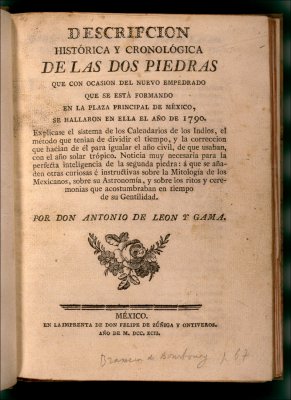Antonio de León y Gama facts for kids
Antonio de León y Gama (1735–1802) was a smart Mexican scientist. He was an astronomer, which means he studied stars and planets. He was also an anthropologist, studying human societies and cultures. Plus, he was a writer.
In 1790, something amazing was found in Mexico City. It was the Aztec calendar stone, also known as the sun stone. This huge stone was buried under the city's main square. Antonio de León y Gama wrote an important book about it. The book's long title means Historical and chronological description of two Stones that were found in the plaza of Mexico in 1790 upon the occasion of laying the new pavement. In this book, he explained how aztec calendars worked.
Contents
Life of Antonio de León y Gama
Antonio de León y Gama was born in Mexico City in 1735. His father was a lawyer who wrote a book about agreements. Sadly, Antonio's mother passed away when he was born. He lived his whole life in Mexico City and died there in 1802.
From 1753 to 1755, he went to a law school called San Ildefonso. He earned a degree there. In 1758, he started working at the Royal Court of Mexico. He stayed there for his entire career. People said he wasn't rich and had many children. He taught himself math and astronomy. He became one of the best Mexican astronomers of his time.
Antonio de León y Gama's Works
Antonio de León y Gama wrote about many different science topics. These included astronomy, medicine, and history. But he is most famous for his book about the Aztec calendar stone.
Here are some of his important writings:
- Astronomy:
- Calendario 1771 (Calendar 1770)
- Calendario 1772 (Calendar 1771)
- Descripción orthográphica universal del eclipse de sol del día 24 de junio de 1778 (Universal orthographic description of the sun eclipse of 24 June 1778)
- Observaciones meteorológicas (Meteorological observations) in Gaceta Mexicana, February 1787.
- Discurso sobre la luz septentrional que se vio en esta ciudad el día 14 de noviembre de 1789 (Talk about the northern light seen in this city on 14 November 1789) in Gaceta Mexicana, October 1789.
- Disertación física sobre la materia y formación de las auroras boreales (Physical discussion on matter and the formation of the auroras borealis), 1790.
- Carta a un amigo (Letter to a friend), in Gaceta Mexicana, April 1801. In this letter, he explained how centuries should be counted.
- Medicine:
- Instrucción sobre el remedio de las lagartijas (On the remedy of wall lizards), 1782. In this book, he discussed using wall lizards as a cure for cancer.
- Respuesta satisfactoria (Satisfactory answer), 1783.
- History:
- Descripción histórica y cronológica de las dos piedras que con ocasión del nuevo empedrado que se está formando en la plaza principal de México, se hallaron en ella el año de 1790 (Historical and chronological description of two Stones that were found in the plaza of Mexico upon the occasion of laying the new pavement).
- Compendio de la historia antigua de la Nueva España, desde sus primeros pobladores hasta despúes de la conquista. This book is about the ancient history of New Spain. It used paintings by indigenous people and old writings.
His Most Famous Book: The Two Stones of Mexico City
This important book was published in 1792. In it, León y Gama wrote about two amazing Aztec artworks. They were found in 1790 in the Zócalo, which is Mexico City's main plaza. These were the sun stone and a statue of Coatlicue, an Aztec goddess.
León y Gama also shared his ideas about how the Aztecs measured time. Unlike writers from earlier times, he praised Aztec society. He admired their scientific and artistic achievements. This fit with the growing feeling of Mexican pride in the late 1700s.
The book was printed by Felipe de Zúñiga y Ontiveros. His printing shop was one of the most important in America back then. The book also included three folded, hand-painted drawings. Because of this book, many people consider Antonio de León y Gama to be the first Mexican archaeologist.
See also
 In Spanish: Antonio de León y Gama para niños
In Spanish: Antonio de León y Gama para niños



